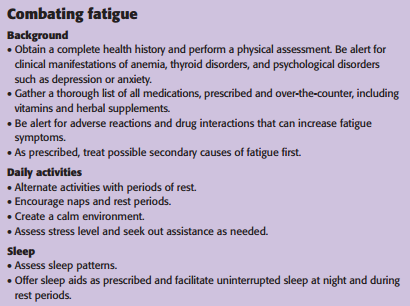Managing fatigue in patients with multiple sclerosis
Why is this important to me?
Fatigue is the most common symptom in MS and is reported by over half of people with the disease. Fatigue is often the most frustrating symptom and the main reason for social isolation and employment problems. Although fatigue has a substantial impact on your quality of life, this symptom can be managed.
What is the objective of this study?
Fatigue is subjective and therefore challenging to define. However, The Multiple Sclerosis Council for Clinical Practice Guidelines defines fatigue as “a subjective lack of physical and/or mental energy that is perceived by the individual or caregiver to interfere with usual or desired activities.” Fatigue is personal, and you define the severity of your fatigue.
When determining the cause of fatigue, you and your health care provider should first rule out or treat reasons other than MS. Other reasons for fatigue may include other diseases you may have and medications you may be taking.
Treatment for fatigue due to MS may include non-drug treatments that increase your energy levels such as:
- Conserving energy: Consider planning your more strenuous activities at a time of day when you are most rested. Also consider naps or daily rest periods.
- Exercise: Although exercise has not been consistently shown to improve fatigue, some studies do suggest a positive effect on fatigue. Be careful, though, because excessive exercise may make fatigue worse.
When non-drug treatment is not effective enough, some drugs may be useful for easing fatigue:
- Amantadine: How this stimulant works to improve fatigue is not known. Around 20-40% of people with MS will experience reduced fatigue when taking this medication.
- Modafinil is another stimulant that is used to treat narcolepsy and may ease fatigue.
| SHARE: | |||||
Original Article
Managing Fatigue in Patients with Multiple Sclerosis
Nursing2012
Carolyn M. Johnson, MSN, RN, CNL, CNRN
MULTIPLE SCLEROSIS (MS) is the most common autoimmune inflammatory demyelinating disease of the central nervous system with signs and symptoms that include weakness, bladder and bowel problems, depression, and memory loss.1,2 However, the most common symptom is fatigue, which is reported by 70% to 90% of patients with MS.3 Fatigue can decrease the quality of life for patients with MS, but it can be managed with proper treatment. This article will take a look at fatigue as it’s experienced by patients with MS and discuss how it can be managed.
Defining Fatigue
A subjective concept, fatigue is difficult to define. The Multiple Sclerosis Council for Clinical Practice Guidelines defines fatigue as “a subjective lack of physical and/or mental energy that is perceived by the individual or caregiver to interfere with usual and desired activities.”4 Fatigue is personal and can be truly defined only by the individual experiencing it. The severity of fatigue is what the patient perceives it to be.5
As nurses, we may be tempted to assess a patient’s fatigue based on comparison to other patients of similar age and gender who also have MS. This may lead to a misrepresentation of the degree of fatigue that the patient feels. Many patients rate their fatigue severity based on their activity level before being diagnosed with MS.5 Patients may have a baseline level of fatigue due to other underlying conditions such as anemia, thyroid abnormalities, liver dysfunction, or sleep disorders.5,6 Over half of patients with MS report that fatigue is their most frustrating symptom and the main reason for social isolation and inability to work.3
Fatigue can be divided into two categories, primary and secondary. Primary fatigue is caused by the MS disease process as the patient progresses through the course of the disease. Secondary fatigue is caused by factors associated with MS progression and treatment, such as depression, adverse reactions to medications, sleep disturbances, and infections.6
Ruling Out Causes
When determining how to treat fatigue in a patient with MS, the first step that the healthcare provider will take is to rule out other possible causes of the fatigue. Assess for secondary causes by obtaining a comprehensive health history. Important areas to include are comorbidities, history of depression, sleep history, mental state, and medications (including prescription and over-the-counter medications, as well as nutritional and herbal supplements) the patient currently takes to treat comorbidities as well as MS symptoms.5-7 Ask if the patient is experiencing any unusual stress, which can also increase a patient’s sense of fatigue. When performing a thorough physical assessment, look for signs of infection, which may cause fatigue. If a secondary cause is noted from the patient history or physical assessment, the healthcare provider will treat the secondary cause first.5-7
Over half of patients with MS report that fatigue is their most frustraing symptom and the main reason for social isolation and inability to work
Increasing Energy Levels Several studies recommend trying nonpharmacologic methods, such as energy conservation and aerobic exercise, before drug therapy when treating secondary causes of fatigue in patients with MS.5,7 If these methods provide only limited or minimal relief, medications may be added to the treatment plan.
- Energy conservation involves adjusting daily activities to coincide with the patient’s energy levels. For example, the patient could schedule the most strenuous activities for the time of day when he or she has the most energy, usually in the morning.8 This may also involve taking a nap or rest period before participating in a high-energy activity scheduled for later in the day. The patient should make daily rest periods or naps part of his or her daily activites.8
- Aerobic activity geared to the patient’s ability can be performed at home or in a healthcare facility.7 Although a few studies have shown that exercise has a positive effect on fatigue in patients with MS, aerobic exercise hasn’t been consistently shown to be effective in reducing fatigue.6,7 However, regular aerobic exercise promotes cardiovascular health and can improve mood.5 This may be especially beneficial for patients with MS who are also experiencing depression, which is more common in patients with MS than in patients with other chronic diseases.9 But be aware that activity can exacerbate fatigue symptoms in some patients.7
See Combating fatigue for an overview of how you can help your patients increase their energy levels.

Pharmacologic Treatment
When treating secondary causes of fatigue doesn’t help, the healthcare provider may prescribe medications aimed at treating fatigue. The most common medications prescribed are the stimulants amantadine and modafinil.5-7,10
Amantadine has been used for MS fatigue since the early 1980s.5 It affects cholinergic, dopaminergic, adrenergic, and glutamatergic neurotransmission. However, its mechanism of action in treating fatigue in MS patients is unknown.11 Twenty to forty percent of patients with MS experience a reduction in fatigue symptoms while taking amantadine.5
The effectiveness of amantadine versus a placebo is supported by several studies.7 Contraindications include delirium/confusion, epilepsy, renal insufficiency, untreated angle closure glaucoma, and hypertension. Common adverse reactions include nausea, dizziness, and insomnia.12
Modafinil is a nonamphetamine stimulant that’s used for the treatment of narcolepsy.2 Common adverse reactions include headache, nausea, nervousness, rhinitis, diarrhea, back pain, anxiety, insomnia, dizziness, and dyspepsia.13
Improving Quality of Life
Fatigue is a common symptom of patients with MS and can have a significant impact on their daily lives. By taking the time to understand your patients’ perception of fatigue, you can help them conserve their energy and improve their quality of life.
REFERENCES
1. Multiple Sclerosis Association of America. What are the symptoms of MS? http://www.msassociation. org/about_multiple_sclerosis/symptoms/?gclid=CMj njsi946ACFQ8NDQodKV25lQ.
2. Olek MJ. Comorbid problems associated with multiple sclerosis in adults. UpToDate. http://www.uptodate.com/contents/comorbidproblems-associated-with-multiple-sclerosisin-adults.
3. Zifko U. Management of fatigue in patients with multiple sclerosis. Drugs. 2004;64(12):1295-1304.
4. Multiple Sclerosis Council Clinical Practice Guidelines: Fatigue and Multiple Sclerosis: Evidencebased Management Strategies for Fatigue in Multiple Sclerosis. Washington, DC: Paralyzed Veterans of America; 1998.
5. Phelan M. Multiple sclerosis: an exploration in the issue of fatigue. J Australasian Rehab Nurse Assoc. 2009;12(2):7-11.
6. Lapierre Y, Hum S. Treating fatigue. Int MS J. 2007;14(2):64-71.
7. Vucic S, Burke D, Kiernan M. Fatigue in multiple sclerosis: mechanisms and management. Clin Neurophysiol. 2010;121(6):809-817.
8. Multiple Sclerosis Association of America. Section 1: fatigue. http://www.msassociation.org/ publications/winter09/cover.story/1.asp.
9. Olek MJ. Epidemiology and clinical features of multiple sclerosis in adults. UpToDate. http://www. uptodate.com/contents/epidemiology-and-clinicalfeatures-of-multiple-sclerosis-in-adults. 10. Kraft GH. What do we know about fatigue? Momentum. 2009;3(1):40-42.
11. Schwid SR, Murray TJ. Treating fatigue in MS patients: one step forward, one step back. Neurology. 2005;64(7):1111-1112. 12. Amantadine prescribing information. http:// www.upsher-smith.com/wp-content/uploads/ 2011/12/LA-Amantadine-Hydrochloride-CapsuleInsert-5001.pdf. 13. Modafinil prescribing information. http://www. modafinil.com/prescribe/index.html.
Carolyn M. Johnson is a direct care nurse at Saint Mary’s Health Services in Grand Rapids, Mich.
The author has disclosed that she has no financial relationships related to this article.

